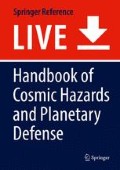Abstract
NASA’s twin STEREO probes, launched in 2006, have advanced the art and science of space weather forecasting more than any other spacecraft or solar observatory. By surrounding the Sun, they provide previously impossible early warnings of threats approaching Earth as they develop on the solar far side. They have also revealed the 3D shape and inner structure of CMEs – massive solar storms that can trigger geomagnetic storms when they collide with Earth. This improves the ability of forecasters to anticipate the timing and severity of such events. Moreover, the unique capability of STEREO to track CMEs in three dimensions allows forecasters to make predictions for other planets, giving rise to the possibility of interplanetary space weather forecasting too. STEREO is one of those rare missions for which “planetary hazards” refers to more than one world. The STEREO probes also hold promise for the study of comets and potentially hazardous asteroids.
References
Arge CN, Pizzo VJ (2000) Improvement in the prediction of solar wind conditions using near-real time solar magnetic field updates. J Geophys Res 105:10465
Baker DN et al (2013) A major solar eruptive event in July 2012: defining extreme space weather scenarios. Space Weather 11:585
Bougeret JL et al (2008) S/WAVES: the radio and plasma wave investigation on the STEREO mission. Space Sci Rev 136:1–4
Byrne JP, Maloney SA, McAteer RTJ, Refojo J, Gallagher PT (2010) Propagation of an Earth-directed coronal mass ejection in three dimensions. Nat Commun 1:74
DeForest CE, Howard TA, Tappin SJ (2011) Observations of detailed structure in the solar wind at 1 AU with STEREO/HI-2. Astrophys J 738:103
DeForest CE, Howard TA, McComas DJ (2013) Tracking coronal features from the low corona to earth: a quantitative analysis of the 2008 December 12 coronal mass ejection. Astrophys J 769:43, and references therein
Galvin AB et al (2008) The Plasma and Suprathermal Ion Composition (PLASTIC) investigation on the STEREO observatories. Space Sci Rev 136:1–4
Guhathakurta M (2013) Interplanetary space weather: a new paradigm. EOS Trans Am Geophys Union 94(18):165
Howard RA et al (2008) Sun Earth Connection Coronal and Heliospheric Investigation (SECCHI). Space Sci Rev 136:1–4
Kaiser ML et al (2008) The STEREO mission: an introduction. Space Sci Rev 136:1–4
Le Chat G et al (2013) Interplanetary nanodust detection by the solar terrestrial relations observatory/waves low frequency receiver. Sol Phys 286:549
Luhmann JG et al (2008) STEREO impact investigation goals, measurements, and data products overview. Space Sci Rev 136:1–4
Mewaldt RA et al (2014) A 360° view of solar energetic particle events, including one extreme event, submitted to the Proceedings of the International Cosmic Ray Conference 2014
National Research Council (2008) Severe space weather events – understanding societal and economic impacts, space studies board report. National Academic Press, Washington, DC, pp 3 and 77
Odstrcil D et al (2004) Initial coupling of coronal and heliospheric numerical magnetohydrodynamic codes. J Atmos Solar-Terrestrial Phys 66:1311
Patsourakos S, Vourlidas A, Stenborg G (2012) Direct evidence for a fast coronal mass ejection driven by the prior formation and subsequent destabilization of a magnetic flux rope. Astrophys J 764:125
Russell CT et al (2013) The very unusual interplanetary coronal mass ejection of 2012 July 23: a blast wave mediated by solar energetic particles. Astrophys J 770:38
Schrijver CJ, Title AM (2011) Long-range magnetic couplings between solar flares and coronal mass ejections observed by SDO and STEREO. J Geophys Res 116:A4
St. Cyr OC et al (2009) STEREO SECCHI and S/WAVES observations of spacecraft debris caused by micron-size interplanetary dust impacts. Sol Phys 256:475–488
Thernisien A, Vourlidas A, Howard RA (2006) Modeling of flux rope coronal mass ejections. Astrophys J 652:763
Vourlidas A, Lynch BJ, Howard RA, Li Y (2013) How many CMEs have flux ropes? Deciphering the signatures of shocks, flux ropes, and prominences in coronagraph observations of CMEs. Sol Phys 284:179
Vourlidas A et al (2007) First direct observation of the interaction between a comet and a coronal mass ejection leading to a complete plasma tail disconnection. Astrophys J 668:L79
Wraight KT, White GJ, Bewsher D, Norton AJ (2011) STEREO observations of stars and the search for exoplanets. Mon Not R Astron Soc 416:2477
Wraight KT, Fossati L, White GJ, Norton AJ, Bewsher D (2012) Bright low mass eclipsing binary candidates observed by STEREO. Mon Not R Astron Soc 427:2298
Acknowledgments
The authors would like to thank the STEREO SECCHI, SWAVES, IMPACT, and PLASTIC investigations for their support in the preparation of this manuscript. Additionally, the authors gratefully acknowledge contributions and editorial support from Nat Gopalswamy, Joseph Gurman, Russell Howard, Ian Richardson, William Thompson, and Angelos Vourlidas.
Author information
Authors and Affiliations
Corresponding author
Editor information
Editors and Affiliations
Rights and permissions
Copyright information
© 2014 Springer International Publishing Switzerland (outside the USA)
About this entry
Cite this entry
Guhathakurta, M., Thompson, B.J. (2014). STEREO as a “Planetary Hazards” Mission. In: Allahdadi, F., Pelton, J. (eds) Handbook of Cosmic Hazards and Planetary Defense. Springer, Cham. https://doi.org/10.1007/978-3-319-02847-7_17-1
Download citation
DOI: https://doi.org/10.1007/978-3-319-02847-7_17-1
Received:
Accepted:
Published:
Publisher Name: Springer, Cham
Online ISBN: 978-3-319-02847-7
eBook Packages: Springer Reference EngineeringReference Module Computer Science and Engineering

